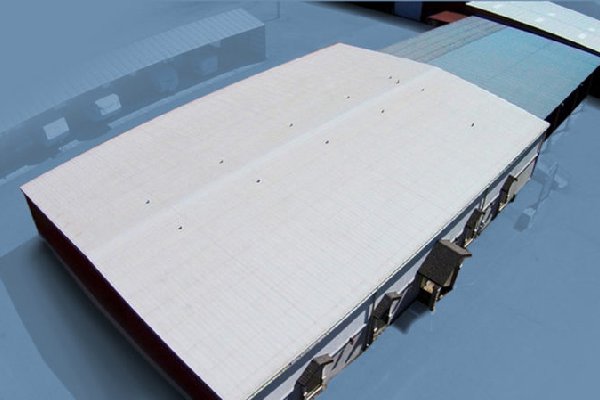The Top 5 Benefits Of Installing A Low Slope Roof

Replacing an aging roof represents a major investment and not one to be approached lightly. Magnify this with the fact it’s an industrial roof, and you could be in for some serious sticker shock.
But before you go with the same old, flat-topped industrial-looking behemoth, it’s time to take another look at the advantages of a low slope roof.
From wind resistance to energy efficiency, durability to a traditional appearance, there are many benefits of installing this roofing system. But how do you know whether or not this type of roof is right for your commercial building?
Read on for a breakdown of the top five benefits associated with installing low slope roofs.
1. Weather and Wind Resistance
The news is filled with reports of extreme weather conditions in Wisconsin on a regular basis. For example, on July 2, 2019, thunderstorms developed across the southeast wreaking havoc with strong wind gusts and heavy rain.
Summer also comes with scorching temperatures and the potential for significant UV damage. And as for winter, we get our fair share of snow, too. The US national average is 28 inches of snow per year. But Madison gets 42 inches, and Northern Wisconsin can see as much as 300.
From strong winds to heavy precipitation and sweltering days, consider a low slope roof for your business. Many prove UV and high-temperature resistant.
What’s more, the right roofing materials can mitigate any potential problems with precipitation buildup.
We’ll come back to these in a bit, but products made with PVC, EPDM, and TPO all prove highly weather and water resistant. And since low slope roofs are engineered to withstand high winds, they come with no inherent wind resistance.
2. Energy Efficiency
Besides weather-related reasons to consider a low sloping roof, climate control factors in. In most structures, particularly those with high sloped roofs, climate control issues and inefficiencies abound.
Why? Because the steep slope of the roof translates into excess space that fills with air. The resultant air impacts how a structure’s cooling and heating systems function.
A low slope roof limits the extra air space in a structure. As a result, controlling the climate within the building proves easier and more efficient.
The optimal low slope allows you enough room for a little attic storage space while maintaining a comfortable interior temperature. No matter the time of year.
3. Affordable Installation and Maintenance
When it comes to installation costs, there are more reasons to rejoice over low slope roofing. They require less material to build. This translates into lower overall installation expenses.
Not bad, right?
And since low slope roofs also prove easier to install, you can expect a reduction in labor costs. In other words, you’ll end up with more room in your budget for upgrades such as purchasing higher-quality roofing materials.
4. Many Durable Options
When you install a Duro-Last low slope roof, you can rest assured of its reliability and durability over the long haul.
But which options do you have when it comes to roofing materials? Let’s start by talking about polyvinyl chloride (PVC) roofing membranes. They have been in use for more than 40 years and are renowned for their toughness.
In fact, many PVC roofing membranes have been known to perform well for upwards of 20 years. PVC membranes can be manufactured in a wide variety of colors although white and gray prove most popular.
Another option available to companies wishing to install low slope roofing is an EPDM system. EPDM refers to an elastomeric compound that’s synthesized from propylene, ethylene, and a small amount of diene monomer.
The result? A synthetic rubber substance that boasts a serious amount of flexibility. EPDM also proves highly resistant to UV, ozone, weather, and abrasion damage.
Besides PVC and EPDM roofing systems, TPO-based roofing presents another reliable option. TPO stands for thermoplastic olefin and is created by combining ethylene-propylene and polypropylene polymers.
TPO membranes often include UV absorbers, flame retardants, pigments, and other ingredients.
5. Aesthetic Considerations
Clearly, the benefits of installing a low slope roof abound. But one we have yet to hit on is the aesthetics associated with this type of roof.
Unlike flat-topped roofs that evoke an industrial feel, low slope roofs have an inherent beauty to them. They evoke a more traditional look that will make your storefront or facility not only more attractive but also more welcoming.
In particular, Duro-Last manufactures a pleasing line of roofing materials in a variety of colors, shingle print, and gravel print.
So, you can opt for an attractive appearance while knowing that your roof is durable, energy-efficient, wind-proof, and much more.
The Right Low Slope Roof for Your Facility
Could your commercial building use a roof upgrade? Then, maybe it’s time to explore the advantages of a Duro-Last low slope roof. Not only are they flame resistant but they won’t crack with the expansion and contraction of a building.
They prove puncture and tear-proof. And since they’re not metal, they don’t corrode or rust. Duro-Last roofs don’t require periodic mechanical repairs, and they’re resistant to caustic chemicals and extreme temperatures.
Ready to learn more about whether or not a low slope roofing system is right for your organization? Request a quote today and find out more about Nasi Roofing’s knowledgable, reliable roof installation services.
